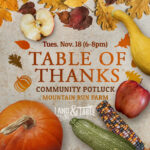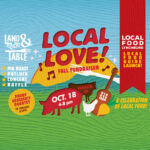Will will wake up to sustainable alternatives to factory farms?[/caption] Here is another essay by agricultural economist, John Ikerd, who has repeatedly warned that industrial meat production and CAFOs (aka: concentrated animal feeding operations) are negatively impacting rural communities all over our nation – and have been doing so for along time. Will we listen? And will we consider the sustainable alternatives?
CAFOs, meaning large-scale confinement animal feeding operations, are the epitome of industrial agriculture. Therefore, the economics impacts of CAFOs on rural communities are a direct reflection of the economic nature of industrial agriculture. The agricultural establishment[iii] boasts loudly about the economic efficiency of American agriculture. Each decade since the 1930s, fewer American farmers have been able to feed more Americans with an ever-decreasing share of consumers’ incomes spent for food. This has been a direct consequence industrialization of American agriculture, as reflected in ever-increasing specialization, standardization, and consolidation of control into fewer, larger operations. The economic efficiency of industrial agriculture has been impressive, but what about the long run economic costs? The quest for economic efficiency has transformed American agriculture from a system of small, diversified, independently operated, family farms into a system of large-scale, mechanized, corporately controlled agribusinesses. In the process, millions of farm families have been forced off their land and thousands of small farming communities have withered or died. The social costs have been undeniably tremendous, but since they aren’t economic costs, they have gone uncounted. There are no short run economic benefits from investing in healthy rural communities. The ecological costs of economic efficiency also have gone uncounted and thus largely ignored. Today, only the most diehard industrialists bother to deny that industrial farming has degraded the productivity of the land through erosion and contamination and has polluted the natural environment, including streams and groundwater, with chemical pesticides, fertilizers, infectious diseases and other biological contaminants from livestock manure. However, there are no short run economic benefits from protecting the natural environment. The basic problem arises from the fact that economic value is inherently individualistic. Since economic value accrues to individuals, it must be expected to accrue during the lifetime of the individual. Life is inherently uncertain; so, economics places a premium on the present relative to the future. At a market determined interest rate of 7%, for example, economic benefits expected to accrue a decade in the future are worth less than fifty cents on the dollar today. Economic value, being individualistic, simply does not include value that accrues to society or humanity. It makes no economic sense to invest in protecting or renewing natural or human resources if benefits accrue to those of future generations, rather than to individual investors. However, all economic value ultimately arises from either natural or human resources. Once the economic productivity of nature and society is depleted, there will be no source of economic value. Based on everything we know about nature and society, the economy places far too little value on the future to ensure that those of future generations will be able to meet their basic economic needs. Regardless of when the earth’s resources are ultimately depleted, an industrial economy driven by the economic bottom line, which includes industrial agriculture, quite simply is not sustainable. CAFOs epitomize of this lack of sustainability. Virtually every argument made in support of CAFOs is based their supposed economic benefits to rural communities. However, CAFOs have consistently failed to live up to the economic promises. CAFOs may generate profits for a few local investors but they do not promote rural economic development. CAFO operators do business wherever they can get the best deal, which typically is not in the local community. They routinely place greater demands on local roads and bridges than they pay in local taxes. The few low-paying jobs go mostly to immigrants to the community, whose demands for new public services outweigh any additions to the local tax base. In addition, most of the short run economic benefits typically go to outside corporate investors. While the promised economic benefits of CAFOs are illusions, their environmental and social costs are real. Today, there is no legitimate basis for the denial of those costs. Virtually every socioeconomic study done on the subject in the past 50-years has shown that both the social and economic quality of life is better in communities characterized by small, diversified family farms. Even in cases where larger, specialized farming operations have brought more jobs and total income to communities, they have also brought greater inequity in income distribution. The rich got richer and the rest became poorer, leaving communities with fewer middle-income taxpayers to support education, health care, and other local public services. The only studies finding anything positive about CAFOs are those that focused solely on short run economic impacts, while ignoring the negative impacts of income inequity on overall quality of life in communities. A 2006 study commissioned by the North Dakota Attorney General’s Office provides a review of 56 socioeconomic studies concerning the impacts of industrial agriculture on rural communities. It concluded: “Based on the evidence generated by social science research, we conclude that public concern about the detrimental community impacts of industrialized farming is warranted. In brief, this conclusion rests on five decades of government and academic concern with this topic, a concern that has not abetted but that has grown more intense in recent years, as the social and environmental problems associated with large animal confinement operations [CAFOs] have become widely recognized (italics added).”[1] CAFOs are the epitome of industrial agriculture and industrial agriculture simply cannot sustain rural communities. Reams of scientific reports also document clear linkages between the obvious air and water pollution from CAFOs and public health risks. Those risks include contamination of air, water, soil, and foods with toxic chemicals, infectious diseases, antibiotic resistant bacteria, and E. coli 0157:H7.[2] A prestigious commission funded by the Pew Charitable Trust concluded in their 2008 report, “The current industrial farm animal production system often poses unacceptable risks to public health, the environment and the welfare of the animals… the negative effects of the system are too great and the scientific evidence is too strong to ignore. Significant changes must be implemented and must start now.”[3] The preponderance of scientific evidence leaves little credible doubt that CAFOs represent significant environmental and health risks to rural residents. As CAFOs degrade the social and ecological integrity of rural communities, they are destroying the foundation for future economic prosperity. Even so, people in rural communities are told by the agricultural establishment there are simply no logical alternatives to large-scale, corporately controlled agriculture. They claim we simply must have industrial agriculture to feed a growing global population. They dismiss the new opportunities for farmers emerging in response to food safety, environmental, and social concerns as small niche markets that hold promise for only a few, small, specialty farmers. However, the reality again is quite different. Together, the new markets for foods produced by socially and ecologically responsible farming methods – sustainably produced foods – are creating the future of American agriculture. The market for organic foods has been growing at a rate approaching 20% per year over the past 20 years, doubling every three to four years. This growing preference for organic is not simply a reflection of consumers trying to avoid pesticide and agrichemical residues in their foods. They are concerned about genetically modified foods, hormones and antibiotics, e-coli, obesity, and a wide range of social and ethical issues, including the impacts of their food choices on farmers, farm workers, farm animals, and stewardship of our land and water resources. They want food with ecological and social integrity – food they can trust. Recent surveys indicate that around three-fourths of American consumers have a strong preference for locally grown foods preferably grown on small family farms. They want to know where their food comes from, how it is produced, and who produced it. A growing number of Americans have simply lost confidence in the integrity of the corporations and the government agencies with whom the integrity of the food system has been entrusted. Increasingly, they are buying as much of their food as possible from local sources – from people they know and trust. Among the most profitable of the new sustainable/local alternatives are grass-based, free-range, and pastured livestock and poultry. Pastured and free-range poultry production became popular because of growing concerns about health and food safety and about inhumane growing conditions in industrial poultry production. Grass-based livestock operations initially gained popularity because of low investment requirements and low cost of production. However, it has become increasingly popular because of evidence of important health benefits in grass-fed products compared with products from animals fed in confinement. Pastured and free-range livestock production also allows producers to avoid hormones and antibiotic concerns and to meet the humane standards of production demanded by an increasing number of consumers. Producing hogs on deep bedding in hoop houses provides another viable alternative to the slatted floors, cramped crates, and manure lagoons of CAFOs. Studies at Iowa State University have shown that hogs can be produced in hoop houses just as efficiently as in CAFOs; they just require more and better management. Studies at various universities have shown grass-based dairy farms to be more profitable than confinement dairy operations, in fact, among the most profitable of all farming operations. When farmers take the initiative to process and market their own meat, milk, and cheese directly to caring consumers, their profits are often multiplied. The markets for sustainable/local meats and milk are growing far faster than are the numbers of farmers willing to produce for these new markets. The number of farmers markets – where meat, cheese, and eggs are taking their place along with local produce – has more than doubled in the past ten years. Increasingly, CSA’s and food buying clubs are offering their subscribers animal products along with vegetables and berries.[4] Sustainable livestock, dairy, and poultry producers also have opportunities to market through local and regional cooperatives and organizations such as Organic Valley, Country Natural Beef, Shepherd’s Grain, and Red Tomato.[5] There are a growing number of profitable and sustainable alternatives for farmers. CAFOs represent the agriculture of the past, not the agriculture of the future. Contrary to claims of critics, sustainable farmers can produce just as much or more food than can their industrial farming neighbors. Sustainable farming just requires more intensive management – meaning more imagination and creativity, a better understanding of the land and people, and a commitment to working in harmony with nature and society. As a result, sustainable farming will require more farmers to produce enough food for the future, but what’s wrong with having more thinking, caring farmers? In addition, sustainable farming relies less on fossil energy and releases fewer greenhouse gasses, both of which will diminish any economic advantages for industrial agriculture in the future. Industrial agriculture simply cannot meet the needs of future generations; we must create a sustainable agriculture that can. In summary, the highly touted productivity and efficiency of industrial agriculture is largely an economic illusion. In fact, food in America isn’t really all that cheap; most of us are simply in a position to avoid paying the full costs of our food. Some our food costs have been paid by family farmers who have been driven out of business or to the verge of bankruptcy. Some have been paid by rural communities that have withered and died as farm families have been forced off the land. And some have been paid by migrants and other farm workers who see no alternative to exploitative wages and working conditions. These unpaid costs are paid by people who, through no fault of their own, are at the mercy of those with more economic power. Much of the food costs we don’t pay are being billed to our children, grandchildren, and others of future generations. When our choices of “cheap food” lead to environmental degradation and social injustice, we are not really avoiding those costs; we are simply charging them to future generations by destroying the social and ecological foundation for their economy. Those of future generations can’t express their preferences and values either in the marketplace or at the ballot box. They can’t choose to pay the full cost of food nor can they redirect government programs to support agricultural sustainability. They must depend on us. People in rural America today are confronted with choices that will shape their future, for either better or worse. Many rural places still have clean air, clean water, open spaces, scenic landscapes, and opportunities for a life of peace, quiet, and privacy. The people in many rural communities still have a sense of belonging; the people know and care about each other. Crime rates are still low and a sense of safety and security is the norm. These attributes are becoming increasingly scarce, even in rural America, and thus are becoming increasingly valuable. Now is the time for rural people to rise up and reclaim their right to protect their community, their environment, and their economy from industrial agriculture. Now is the time for rural people to confront the economic realities of industrial agriculture and to choose the alternative of agricultural sustainability. Now is the time for rural people to create good places to live, where their children and children’s children will choose to live and can flourish in the future. Now is the time for rural people to break free of the forces of short run, individual economic self-interest and to invest in the long run economic future of their communities.
End Notes [i] Prepared for presentation at Annual Meeting of Jefferson County Farmers and Neighbors Inc., Fairfield, IA, October 7, 2009. [ii] John Ikerd is Professor Emeritus, University of Missouri, Columbia, MO – USA; Author of, Sustainable Capitalism, http://www.kpbooks.com , A Return to Common Sense, http://www.rtedwards.com/books/171/, Small Farms are Real Farms, Acres USA , http://www.acresusa.com/other/contact.htm,and Crisis and Opportunity: Sustainability in American Agriculture, University of Nebraska Press http://nebraskapress.unl.edu; Email: JEIkerd@centurytel.net; Website: http://web.missouri.edu/~ikerdj/. [iii] The “agricultural establishment” refers to The U.S. Department of Agriculture, Agricultural Universities, Farm Commodity Organizations, The Farm Bureau Federation, and Agribusiness Corporations. [1] Curtis Stofferahn, “Industrialized Farming and Its Relationship to Community Well-Being: an Update of the 2000 Report by Linda Labao,” special report prepared for the North Dakota, Office of Attorney General, http://www.und.edu/org/ndrural/Lobao%20&%20Stofferahn.pdf (accessed December 2006). [2] Robert Lawrence, MD, Johns Hopkins Bloomberg School of Public Health, “Superfund Laws and Animal Agriculture,” Subcommittee on Environment and Hazardous Materials, November 16, 2005. http://energycommerce.house.gov/reparchives/108/Hearings/11162005hearing1714/Lawrence.pdf [3] Pew Commission on Industrial Farm Animal Production: Putting Meat on The Table: Industrial Farm Animal Production in America, http://www.pewtrusts.org/news_room_detail.aspx?id=38438 , full report, http://www.ncifap.org/. [4] Oklahoma Food Cooperative, http://www.oklahomafood.coop/ and Idaho’s Bounty http://www.idahosbounty.org/ [5] Agriculture of the Middle, “Value Chain Case Studies Provide Mid-Scale Food Enterprises,” http://www.agofthemiddle.org/]]>



